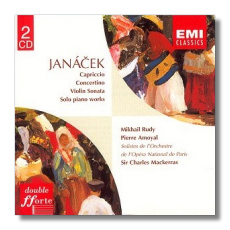
The Internet's Premier Classical Music Source
Related Links
- Janáček Reviews
- Latest Reviews
- More Reviews
-
By Composer
-
Collections
DVD & Blu-ray
Books
Concert Reviews
Articles/Interviews
Software
Audio
Search Amazon
Recommended Links
Site News
 CD Review
CD Review
Leoš Janáček

Chamber Music
- Conte for Cello & Piano
- Presto
- Sonata for Violin & Piano
- Capriccio for Piano and Seven Wind Instruments
- Concertino for Piano & Chamber Orchestra
Mikhail Rudy, piano
Pierre Amoyal, violin
Gary Hoffman, cello
L'Orchestre de l'Opera National de Paris/Charles Mackerras
EMI Classics 55585 2
I always love encountering a new release of Leoš Janáček's chamber music. Unlike his operas, his sonatas, quartets, and concertinos seem more accessible, less rooted to their time, and more easily assimilated into the repertoire. They tend to be eccentric, with such intricate instrumental blendings and tempo shifts that they have low tiring speeds. I can listen to them many times and discover new facets. The Concertino for Piano and Chamber Ensemble (1925) is such a work. After its leisurely introduction, Janáček subtly varies the repetitive dialog between the piano and the horn. This Mackerras recording is good, but I prefer an earlier one by the Netherlands Wind Ensemble (Chandos 9399), conducted by Thierry Fischer. The sense of timing and choice of tempi seem more logical, and the instruments are more assertive. The most notable difference between the two recordings is in the tempo shifts. Most of the time Mackerras' handles them well, yet he often performs a bar too fast or too slow; on the other hand, Fischer feels more precise. He clearly knows the corners and quirks in this music and resists the impulse to add more to it.
The Tale (Conte) for Cello and Piano (1923) and the Sonata for Violin and Piano (1914) are charming, less disturbing pieces. In the first, based on a Russian fairy tale, pianist Mikhaïl Rudy and cellist Gary Hoffman create a mood of intense Brahmsian lyricism. The hesitant dialogue between the cello and piano, particularly in the first movement, conveys the conflicting emotions of the lovers as they try to assess each other. The Sonata for Violin and Piano has a languid pre-war aura. The melody begins as a folk theme, then unexpectedly turns into a nocturne. The insistent melodies of the Allegretto foreshadow his first string quartet while the concluding dumka theme, with its sweeping piano and retorting violin, may refer to impending war. This compelling piece, splendidly played, never let my attention wander.
Like Serge Prokofieff's Fourth Piano Concerto and Maurice Ravel's Concerto for the Left Hand, the Capriccio for Piano and Seven Wind Instruments was written for a one-handed pianist wounded in the First World War. A bizarre piece, it was originally called Defiance. It does seem as though its choppy rhythms and somber passages convey both the horror of war and the defiance of its survivor, the patron-pianist Otakar Hollman. Yet Janáček soon changed its name to Capriccio and in his last interview stated that the piece was "nothing but pranks and puns." Which Janáček should we believe? The frenetic fits and starts in the Adagio and the brash ritornellos suggest his playful side, yet some of the horn passages appear to be mocking martial refrains. As with his interpretation of the Concertino for Piano and Chamber Ensemble, Mackerras offers the more idiosyncratic interpretation, with harsher lines within measures. Fischer's version flows more easily and doesn't showcase the piano as much, particularly in the last movement. How do you like your Janáček?
Copyright © 1998, Peter Bates


















